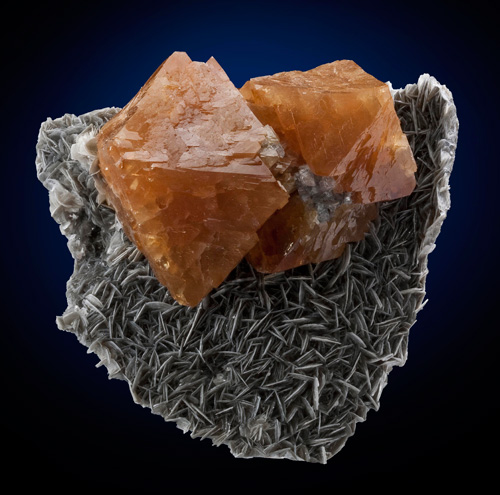The Mineral scheelite

Scheelite is an important ore mineral, and is well-known among collectors for its distinctly colored crystals associated with brilliant fluorescence. It forms a series with the rarer mineral Powellite, which contains molybdenum in place of the tungsten. Scheelite is named after the Swedish chemist Karl Wilhelm Scheele (1742-1786). Scheele is credited with the discovery of tungsten within the Scheelite.
Color
Bright orange, yellow, brown, smoky brown, and tan. Rarely white, colorless, grayish-blue, purple, or pink.
Crystal System
Tetragonal
Properties
Streak
White to light yellow |
Hardness
4.5 - 5 |
Transparency
Transparent to translucent |
Specific Gravity
5.9 - 6.1 |
Luster
Adamantine or greasy |
Cleavage
3,1;2,1 |
Fracture
Conchoidal to uneven |
Tenacity
Brittle |
Other ID Marks
Strongly fluorescent bluish-white.
|
Uses
Scheelite is an important ore of Tungsten. Good crystals are rare and expensive, and highly desired by mineral collectors. Scheelite also makes an important mineral among fluorescent mineral collectors.
Noteworthy Localities
The finest Scheelite crystals, often as bright orange pseudo-octahedrons on a Muscovite matrix, come from Mt. Xuebaoding, in Pingwu, Sichuan Province, China. Smoky crystals come from the Yaogangxian Mine, Chenzhou, Hunan Province, China. Outstanding, sharply crystallized pseudo-octahedral Scheelite crystals came from the Tae Hwa Mine, Neungam-ri, South Korea. Bright orange, sharp crystals, resembling those of Pingwu, have been found at Gharmung, in the Skardu District, Pakistan.
A uniquely colored, dark grayish-blue form of Scheelite came from Baia Sprie (Felsöbánya), Maramures, Romania; and fleshy-colored dipyramidal crystals from Traversella, Torino Province, Italy. A deep orange Scheelite came from the Morro Velho Mine, Nova Lima, Minas Gerais, Brazil; and extremely large crystals were found in the Turmalina Mine, Piura, Peru.
In the U.S., brownish-orange floater crystals of Scheelite were found in the Cohen Mine, Cochise Co., Arizona. Brown, smoky crystals came from Camp Bird Mine, Ouray, Ouray Co., Colorado; and unique white and colorless crystals once came from the Greenhorn Mountains, Kern Co., California. White to light yellow Scheelite is well-known from Trumbull, Fairfield Co., Connecticut.
Distingushing Similar Minerals
Fluorite - Much lower specific gravity.
Zircon and Spinel - Much harder, lack white fluorescence.